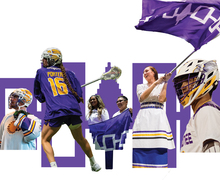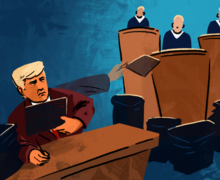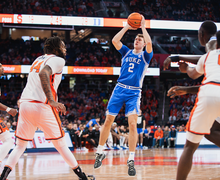Syracuse punter Nolan Cooney overcame cancer at 16, leads ACC in yards
Max Freund | Staff Photographer
This season, Nolan Cooney leads the ACC in punt yards.
The Daily Orange is a nonprofit newsroom that receives no funding from Syracuse University. Consider donating today to support our mission.
Nolan Cooney was back to playing sports three days after receiving his last chemotherapy treatment. It was his plan all along. The then-high school junior knew the state semifinal basketball game would be on March 7, and he set a goal of playing that day.
At the Community College of Rhode Island’s Vincent A. Cullen Field House, Nolan tapped the scorer’s table and walked onto the court. Peers — and rival fans — chanted his name, waving towels and cheering. Everyone in attendance knew of his testicular cancer diagnosis and subsequent recovery, said his father Joseph Cooney.
“It was one of those cool, made for TV moments when he came in,” Joseph said. “I don’t think it was emotional for him because he expected to be there. This was his goal and he knew he was going to be there.”
Days before, Nolan was nearing the end of his nine week treatment, which included over 30 chemotherapy infusions at the Lifespan Cancer Center in The Miriam Hospital. The medicine drained his energy, sapped his hunger and prevented him from doing what he loved: being a three-sport athlete.
“I spent a lot of time on the couch. My dad was there with me for a lot of it,” Nolan said of chemotherapy. “They’re your best support system you can ever have. I felt like they were going through more pressure than I was. If I kept a positive mindset, they felt that same way.”
But after Nolan’s last treatment, he ventured away from baseball, basketball and soccer and into punting. He attended Bridgton Academy — a prep school in Maine — after high school and before walking on at Syracuse. Now the starting punter for the Orange, Nolan was rated the best punter in the nation by Pro Football Focus. He’s tallied 18 punts inside the 20-yard-line and has had 20 that have topped 50 yards, the most in the Atlantic Coast Conference.
When he was young, Nolan often threw a tennis ball against a wall, played catch with his dad, practiced his basketball shooting or rounded friends up for a pick-up game. He always had a ball in his hands, his dad said.
Joseph thought his son would play sports in college, but he wasn’t sure which one. He noticed that Nolan excelled at punting as a soccer goalie, often booting the ball up to the halfway mark.

Katelyn Marcy | Digital Design Director
“He was always playing sports,” Joseph said. “It wasn’t until his junior year that he had to stop.”
After Nolan’s junior year of soccer, his general practitioner noticed one of his testicles was enlarged. An ultrasound deemed it cancerous, and he had surgery within a week to remove the tumor, but the cancer had spread to his lungs.
As he walked out of the hospital that November day, Nolan told his dad he was going to defeat the cancer. It wasn’t going to affect his athletic career.
Nolan always enjoyed activities where he can establish goals for himself, Joseph said. It’s why he enjoys lifting weights at Syracuse and partially why he plays sports: it’s a tangible activity he can constantly improve at. But this new goal, where he would conquer cancer and play the three days after he completed chemotherapy, was by far his toughest yet.
“When he said ‘I’m going to play basketball,’ we were shocked,” Joseph said.
The treatment meant Nolan was unable to participate in many activities for more than two months. He tried to watch East Greenwich High School’s games from afar, but the medicine compromised his immune system, and he was constantly sick. His body temperature swung from sweats to chills, he was constantly nauseous and his headache seemed to never end.
Passing time wasn’t easy. He watched basketball, football and hockey on TV with his dad. He tried to exercise as best he could, but he sometimes had to stop after a few minutes.
Early during the nine weeks, former Tour de France winner and testicular cancer survivor Lance Armstrong called Nolan. A friend involved with Armstrong’s foundation told the cyclist of Nolan’s situation. On the phone, Armstrong told Nolan what to expect from the medicine, what he could or couldn’t eat and the type of pain he may feel.

Nolan Cooney, pictured holding for Syracuse’s kicker, has 20 punts over 50 yards. Corey Henry | Senior Staff Photographer
Joe Andruzzi, a former New England Patriot and Super Bowl winning offensive lineman, also visited Nolan. A cancer survivor who provides support to families affected by the disease in the New England area, Andruzzi let Nolan wear his three Super Bowl rings and discussed the fortitude he needed for the coming weeks.
“It meant the world to me,” Nolan said.
The visits from Armstrong and Andruzzi gave Nolan provided him with relief and the confidence he needed to keep going, Joseph said.
It was that mindset that kept Nolan focused on returning for the semifinal game. When the moment finally came, Joseph said it was surreal. Nolan only played a few plays, and East Greenwich fell to Sanchez Complex by two points. But Nolan had a new objective.
A kicking tee addressed to Nolan arrived that February. He had never played football before, but he had an innate sense that he could thrive at punting. He learned the proper technique off YouTube and began to practice as he regained the strength lost during chemotherapy.
“It was not long after treatment and we sat down and said ‘Why don’t (we) look at one of these kicking camps?’” Nolan said.
Nolan had a new goal in mind: become a Division-I punter.
Published on November 10, 2020 at 10:28 pm
Contact Adam: adhillma@syr.edu | @_adamhillman






